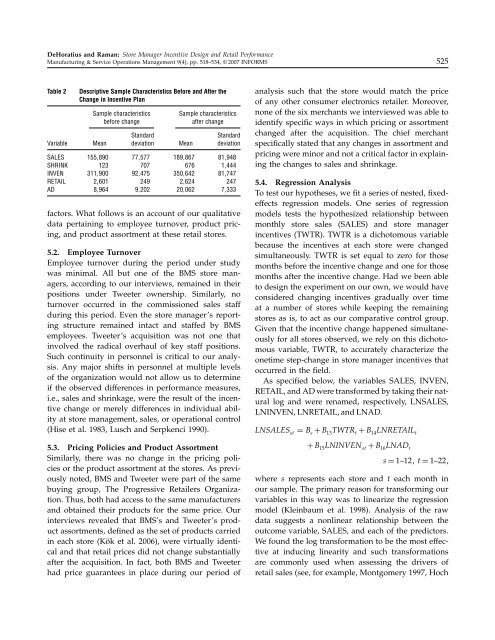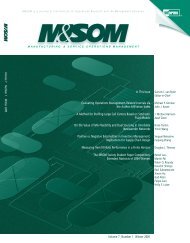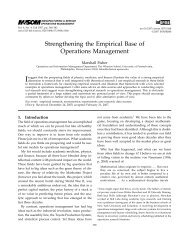Store Manager Incentive Design and Retail Performance: An ...
Store Manager Incentive Design and Retail Performance: An ...
Store Manager Incentive Design and Retail Performance: An ...
You also want an ePaper? Increase the reach of your titles
YUMPU automatically turns print PDFs into web optimized ePapers that Google loves.
DeHoratius <strong>and</strong> Raman: <strong>Store</strong> <strong>Manager</strong> <strong>Incentive</strong> <strong>Design</strong> <strong>and</strong> <strong>Retail</strong> <strong>Performance</strong><br />
Manufacturing & Service Operations Management 9(4), pp. 518–534, © 2007 INFORMS 525<br />
Table 2 Descriptive Sample Characteristics Before <strong>and</strong> After the<br />
Change in <strong>Incentive</strong> Plan<br />
Sample characteristics Sample characteristics<br />
before change after change<br />
St<strong>and</strong>ard St<strong>and</strong>ard<br />
Variable Mean deviation Mean deviation<br />
SALES 155�890 77�577 189�867 81�948<br />
SHRINK 123 707 676 1�444<br />
INVEN 311�900 92�475 350�642 81�747<br />
RETAIL 2�601 249 2�624 247<br />
AD 8�964 9�202 20�062 7�333<br />
factors. What follows is an account of our qualitative<br />
data pertaining to employee turnover, product pricing,<br />
<strong>and</strong> product assortment at these retail stores.<br />
5.2. Employee Turnover<br />
Employee turnover during the period under study<br />
was minimal. All but one of the BMS store managers,<br />
according to our interviews, remained in their<br />
positions underTweeterownership. Similarly, no<br />
turnover occurred in the commissioned sales staff<br />
during this period. Even the store manager’s reporting<br />
structure remained intact <strong>and</strong> staffed by BMS<br />
employees. Tweeter’s acquisition was not one that<br />
involved the radical overhaul of key staff positions.<br />
Such continuity in personnel is critical to our analysis.<br />
<strong>An</strong>y majorshifts in personnel at multiple levels<br />
of the organization would not allow us to determine<br />
if the observed differences in performance measures,<br />
i.e., sales <strong>and</strong> shrinkage, were the result of the incentive<br />
change or merely differences in individual ability<br />
at store management, sales, or operational control<br />
(Hise et al. 1983, Lusch <strong>and</strong> Serpkenci 1990).<br />
5.3. Pricing Policies <strong>and</strong> Product Assortment<br />
Similarly, there was no change in the pricing policies<br />
or the product assortment at the stores. As previously<br />
noted, BMS <strong>and</strong> Tweeterwere part of the same<br />
buying group, The Progressive <strong>Retail</strong>ers Organization.<br />
Thus, both had access to the same manufacturers<br />
<strong>and</strong> obtained theirproducts forthe same price. Our<br />
interviews revealed that BMS’s <strong>and</strong> Tweeter’s product<br />
assortments, defined as the set of products carried<br />
in each store (Kök et al. 2006), were virtually identical<br />
<strong>and</strong> that retail prices did not change substantially<br />
afterthe acquisition. In fact, both BMS <strong>and</strong> Tweeter<br />
had price guarantees in place during our period of<br />
analysis such that the store would match the price<br />
of any other consumer electronics retailer. Moreover,<br />
none of the six merchants we interviewed was able to<br />
identify specific ways in which pricing or assortment<br />
changed afterthe acquisition. The chief merchant<br />
specifically stated that any changes in assortment <strong>and</strong><br />
pricing were minor <strong>and</strong> not a critical factor in explaining<br />
the changes to sales <strong>and</strong> shrinkage.<br />
5.4. Regression <strong>An</strong>alysis<br />
To test ourhypotheses, we fit a series of nested, fixedeffects<br />
regression models. One series of regression<br />
models tests the hypothesized relationship between<br />
monthly store sales (SALES) <strong>and</strong> store manager<br />
incentives (TWTR). TWTR is a dichotomous variable<br />
because the incentives at each store were changed<br />
simultaneously. TWTR is set equal to zero for those<br />
months before the incentive change <strong>and</strong> one for those<br />
months afterthe incentive change. Had we been able<br />
to design the experiment on our own, we would have<br />
considered changing incentives gradually over time<br />
at a number of stores while keeping the remaining<br />
stores as is, to act as our comparative control group.<br />
Given that the incentive change happened simultaneously<br />
for all stores observed, we rely on this dichotomous<br />
variable, TWTR, to accurately characterize the<br />
onetime step-change in store manager incentives that<br />
occurred in the field.<br />
As specified below, the variables SALES, INVEN,<br />
RETAIL, <strong>and</strong> AD were transformed by taking their natural<br />
log <strong>and</strong> were renamed, respectively, LNSALES,<br />
LNINVEN, LNRETAIL, <strong>and</strong> LNAD.<br />
LNSALES st = B s + B 13TWTR t + B 14LNRETAIL t<br />
+ B 15LNINVEN st + B 16LNAD t<br />
s = 1–12� t= 1–22�<br />
where s represents each store <strong>and</strong> t each month in<br />
our sample. The primary reason for transforming our<br />
variables in this way was to linearize the regression<br />
model (Kleinbaum et al. 1998). <strong>An</strong>alysis of the raw<br />
data suggests a nonlinearrelationship between the<br />
outcome variable, SALES, <strong>and</strong> each of the predictors.<br />
We found the log transformation to be the most effective<br />
at inducing linearity <strong>and</strong> such transformations<br />
are commonly used when assessing the drivers of<br />
retail sales (see, for example, Montgomery 1997, Hoch




